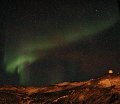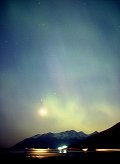
|
Aurora Gallery back to spaceweather.com |

|
| Summary: For the third month in a row, high-latitude observers have spotted auroras triggered by solar wind streams flowing from coronal holes on the Sun. Earth's magnetic field was buffeted by solar wind gusts on May 1st and May 7th-9th. See also the April 2003 aurora gallery. Unless otherwise stated, all images are copyrighted by the photographers. |
| Photographer, Location | Images | Comments | |
|

|
Tom
Hamann, McMurdo Station, Antarctica May 11 |
#1, #2 | T. Hamann: "We don't see good auroras at McMurdo Station very often," says Hamann. Auroras circle Earth's magnetic poles like a donut, bright around the rim and dark in the middle. "Because we're fairly close to the south magnetic pole, we're usually inside the donut where auroras are dim. Faint auroras are hard to see here in 'town' because there is so much light pollution." The orange color of the foreground, he says, is due to 'city lights' reflecting from some fog and low-lying clouds. |
|

|
Lance
Taylor,
Edmonton, Alberta, Canada May 9-10 |
#1, #2, #3, #4, #5, #6, #7, #8 | "It was a fantastic view," says Lance Taylor. "The storm started about 10:00 PM on May 9th and went well into the wee hours of the morning on May 10th. It was the kind of display that covered the horizon quite literally from East to West and North to South: huge fast sweeping curtains and very thin but well defined filaments at the zenith. It was very tough to decide where to put the camera in the sky." |
|

|
Benjamin
Bray, Grand Forks, North Dakota, USA May 7 |
#1, #2, #3, #4 | B. Bray: "The best thing was the wave-like pulsations that moved directly overhead from the northern horizon. A picture just canít capture that kind of activity!" Photo details: Canon AE-1, 50mm lens at f1.8, 15-30 second exposures on ASA 800 Fuji X-TRA. |
|

|
Daryl
Pederson,
Bird Point, Alaska, USA May 7 |
#1, #2, #3 | "With only a short window of darkness, the lights were briefly active throughout much of the sky," says Pederson. |
|

|
Brian
Ruddy,
Isle Royale National Park, Michigan, USA May 1 |
#1, #2, #3, #4 | Photo details: Sony DSC-F707 digital camera, F 2.8, wide angle lens with exposure times ranging from 15 to 30 seconds. |